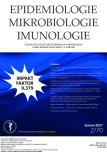Population analysis of Streptococcus pneumoniae serotype 19A by whole genome sequencing in the Czech Republic and in Europe after serotype 19A inclusion in pneumococcal conjugate vaccine
Authors:
J. Kozáková; Z. Okonji; M. Honskus
Authors‘ workplace:
Centrum epidemiologie a mikrobiologie, Státní zdravotní ústav, Praha
Published in:
Epidemiol. Mikrobiol. Imunol. 70, 2021, č. 2, s. 110-117
Category:
Original Papers
Overview
Aim: To present the results of whole genome sequencing (WGS) analysis of Streptococcus pneumoniae serotype 19A and to compare them with the respective data from Europe. The vaccine serotype 19A is widely distributed in the Czech Republic.
Material and methods: WGS was used in this study as the most powerful available method for detailed characterization of S. pneumoniae. Nineteen Czech isolates of S. pneumoniae 19A were analysed and compared with 415 European isolates included in the PubMLST database.
Results: S. pneumoniae serotype 19A causes all types of pathogen - host interaction, from carriage to noninvasive and invasive pneumococcal disease (IPD). In 2010 – 2019, 3872 cases of IPD were reported within the surveillance programme in the Czech Republic, with 323 of these caused by serotype 19A. WGS data of the Czech serotype 19A isolates show a numerous and genetically related subpopulation of three sequencing types: ST-199, ST-416, and ST-3017. Within this subpopulation, the largest is the cluster of nine ST-199 isolates. High relatedness of ST-199 isolates is also confirmed by the fact that all but one isolate, 117/2019 (novel rST- -137805), share the same ribosome sequencing profile - rST-11365. Outside the above-mentioned subpopulation, there are only four isolates that form three separate genetic lines of serotype 19A. A highly similar situation is observed across European countries, where about half of all serotype 19A isolates form a genetically closely related subpopulation (ST-199, ST-416, ST-450, ST-667, ST-3017, and ST-10360) while isolates which are not part of this subpopulation represent a large number of unrelated genetic lines.
Conclusions: The study has shown a mostly homogeneous population of S. pneumoniae serotype 19A to circulate in the post-vaccination era in both the Czech Republic and Europe, with some unrelated isolates located outside this population.
Keywords:
Streptococcus pneumoniae – whole genome sequencing – WGS – vaccine serotype 19A – pneumococcal conjugate vaccine – PCV
Sources
1. Vyhláška č. 275/2010 Sb., kterou se mění vyhláška č. 473/2008 Sb., o systému epidemiologické bdělosti pro vybrané infekce, příloha č. 21 invazivní pneumokoková onemocnění.
2. Ganaie F, Saad JS, McGee L, Tonder AJ, Bentley SD, Lo SW, Gladstone RA, Turner P, Keenan JD, Breiman RF, Nahm MH. A New Pneumococcal Capsule Type, 10D, is the 100th Serotype and Has a Large cps Fragment from an Oral Streptococcus. mBio, 2020;11(3).
3. Vacková Z, Klímová M, Kozáková J. Nová metoda a schéma typizace Streptococcus pneumoniae. Epidemiol Mikrobiol Imunol, 2013;62(2):50–58.
4. Kozáková J, Okonji Z, Šebestová H, Klímová M, Křížová P. Invazivní pneumokokové onemocnění v České republice v roce 2019. Zprávy CEM (SZÚ, Praha), 2019;28(7):277–282.
5. Hausdorff WP, Hoet B, Schuerman L. Do pneumococcal conjugate vaccines provide any cross-protection against serotype 19A? BMC Pediatr, 2010;10:4.
6. Manuál QIAamp DNA Mini Kit. Dostupné na www: https://www. qiagen.com/us/resources/resourcedetail?id=62a200d6-faf4- 469b-b50f-2b59cf738962&lang=en
7. MagAttract HMW DNA Kit. Dostupné na www: https://www.qiagen. com/us/resources/resourcedetail?id=3e331b6c-0742-483b -b74f-a7be2d4c1116&lang=en.
8. Kozáková J, Honskus M, Okonji Z. Implementace a využití metody sekvenace celého genomu (WGS) v surveillance invazivního pneumokokového onemocnění, Česká republika, 2017–2019. Epidemiol Mikrobiol Imunol, 2020;69(3):134–141.
9. https://pubmlst.org/organisms/streptococcus-pneumoniae.
10. Isturiz R, Sings HL, Hilton B, Arguedas A, Reinert RR, Jodar L. Streptococcus pneumoniae serotype 19A: worldwide epidemiology. Expert Review of Vaccines, 2017;16(10):1007–1027.
11. Waight PA, Andrews NJ, Ladhani SN, et al. Effect of the 13-valent pneumococcal conjugate vaccine on invasive pneumococcal disease in England and Wales 4 years after its introduction: an observational cohort study. Lancet Infect Dis, 2015;15:535–543.
12. Steens A, Bergsaker MA, Aaberge IS, Rønning K, Vestrheim DF. Prompt effect of replacing the 7-valent pneumococcal conjugate vaccine with the 13-valent vaccine on the epidemiology of invasive pneumococcal disease in Norway. Vaccine, 2013;16,31(52):6232–6238.
13. Koutouzis EI, Daikos GL, Chatzichristou P, Michos AG, Koutouzi FI, Chrousos GP, Syriopoulou VP. Characteristics of Streptococcus pneumoniae serotype 19A isolates from children in the pre and post Conjugate Vaccine Era. Single center experience 1986– 2015. Vaccine, 2018;23,36(35):5245–5250.
14. Varon E, Cohen R, Béchet S, Doit C, Levy C. Invasive disease potential of pneumococci before and after the 13-valent pneumococcal conjugate vaccine implementation in children. Vaccine, 2015;17,33(46):6178–6185.
15. Weinberger DM, Harboe ZB, Sanders EA, Ndiritu M, Klugman KP, Rückinger S, Dagan R, Adegbola R, Cutts F, Johnson HL, O’Brien KL, Scott JA, Lipsitch M. Association of serotype with risk of death due to pneumococcal pneumonia: a meta-analysis. Clin Infect Dis, 2010;15,51(6):692–699.
Labels
Hygiene and epidemiology Medical virology Clinical microbiologyArticle was published in
Epidemiology, Microbiology, Immunology

2021 Issue 2
Most read in this issue
- Borrelia miyamotoi – another emerging tick-borne pathogen
- Non-O1/non-O139 vibrios – occurrence not only in Europe in recent years
- Substance use and addictive behaviours during COVID-19 confinement measures increased in intensive users: Results of an online general population survey in the Czech Republic
- Risk of latent tuberculosis in the cohort of patients with rheumatoid arthritis in Slovakia
